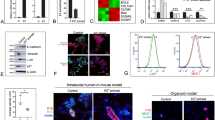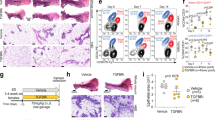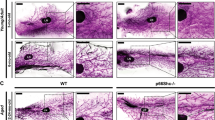Abstract
Reproductive history is the strongest risk factor for breast cancer after age, genetics and breast density1,2. Increased breast cancer risk is entwined with a greater number of ovarian hormone-dependent reproductive cycles, yet the basis for this predisposition is unknown3,4,5. Mammary stem cells (MaSCs) are located within a specialized niche in the basal epithelial compartment that is under local and systemic regulation6. The emerging role of MaSCs in cancer initiation warrants the study of ovarian hormones in MaSC homeostasis. Here we show that the MaSC pool increases 14-fold during maximal progesterone levels at the luteal dioestrus phase of the mouse. Stem-cell-enriched CD49fhi cells amplify at dioestrus, or with exogenous progesterone, demonstrating a key role for progesterone in propelling this expansion. In aged mice, CD49fhi cells display stasis upon cessation of the reproductive cycle. Progesterone drives a series of events where luminal cells probably provide Wnt4 and RANKL signals to basal cells which in turn respond by upregulating their cognate receptors, transcriptional targets and cell cycle markers. Our findings uncover a dynamic role for progesterone in activating adult MaSCs within the mammary stem cell niche during the reproductive cycle, where MaSCs are putative targets for cell transformation events leading to breast cancer.
This is a preview of subscription content, access via your institution
Access options
Subscribe to this journal
Receive 51 print issues and online access
$199.00 per year
only $3.90 per issue
Buy this article
- Purchase on Springer Link
- Instant access to full article PDF
Prices may be subject to local taxes which are calculated during checkout




Similar content being viewed by others
Change history
10 June 2010
Minor corrections were made to affiliation 2 and Fig. 2a, c, d.
References
Veronesi, U., Boyle, P., Goldhirsch, A., Orecchia, R. & Viale, G. Breast cancer. Lancet 365, 1727–1741 (2005)
Kelsey, J. L., Gammon, M. D. & John, E. M. Reproductive factors and breast cancer. Epidemiol. Rev. 15, 36–47 (1993)
Bernstein, L. Epidemiology of endocrine-related risk factors for breast cancer. J. Mammary Gland Biol. Neoplasia 7, 3–15 (2002)
Trichopoulos, D., MacMahon, B. & Cole, P. Menopause and breast cancer risk. J. Natl Cancer Inst. 48, 605–613 (1972)
Apter, D., Reinila, M. & Vihko, R. Some endocrine characteristics of early menarche, a risk factor for breast cancer, are preserved into adulthood. Int. J. Cancer 44, 783–787 (1989)
Brisken, C. & Duss, S. Stem cells and the stem cell niche in the breast: an integrated hormonal and developmental perspective. Stem Cell Rev. 3, 147–156 (2007)
Harmes, D. C. & DiRenzo, J. Cellular quiescence in mammary stem cells and breast tumor stem cells: got testable hypotheses? J. Mammary Gland Biol. Neoplasia 14, 19–27 (2009)
Shackleton, M. et al. Generation of a functional mammary gland from a single stem cell. Nature 439, 84–88 (2006)
Smith, G. H. Label-retaining epithelial cells in mouse mammary gland divide asymmetrically and retain their template DNA strands. Development 132, 681–687 (2005)
Fata, J. E., Chaudhary, V. & Khokha, R. Cellular turnover in the mammary gland is correlated with systemic levels of progesterone and not 17β-estradiol during the estrous cycle. Biol. Reprod. 65, 680–688 (2001)
Graham, J. D. & Clarke, C. L. Physiological action of progesterone in target tissues. Endocr. Rev. 18, 502–519 (1997)
Stingl, J. et al. Purification and unique properties of mammary epithelial stem cells. Nature 439, 993–997 (2006)
Daniel, C. W., Silberstein, G. B. & Strickland, P. Direct action of 17β-estradiol on mouse mammary ducts analyzed by sustained release implants and steroid autoradiography. Cancer Res. 47, 6052–6057 (1987)
Beleut, M. et al. Two distinct mechanisms underlie progesterone-induced proliferation in the mammary gland. Proc. Natl Acad. Sci. USA 107, 2989–2994 (2010)
Haslam, S. Z. & Shyamala, G. Effect of oestradiol on progesterone receptors in normal mammary glands and its relationship with lactation. Biochem. J. 182, 127–131 (1979)
Asselin-Labat, M. L. et al. Gata-3 is an essential regulator of mammary-gland morphogenesis and luminal-cell differentiation. Nature Cell Biol. 9, 201–209 (2007)
Chepko, G. & Smith, G. H. Mammary epithelial stem cells: our current understanding. J. Mammary Gland Biol. Neoplasia 4, 35–52 (1999)
Petersen, O. W., Ronnov-Jessen, L., Howlett, A. R. & Bissell, M. J. Interaction with basement membrane serves to rapidly distinguish growth and differentiation pattern of normal and malignant human breast epithelial cells. Proc. Natl Acad. Sci. USA 89, 9064–9068 (1992)
Asselin-Labat, M. L. et al. Steroid hormone receptor status of mouse mammary stem cells. J. Natl Cancer Inst. 98, 1011–1014 (2006)
Mote, P. A. et al. Overlapping and distinct expression of progesterone receptors A and B in mouse uterus and mammary gland during the estrous cycle. Endocrinology 147, 5503–5512 (2006)
Kariagina, A., Aupperlee, M. D. & Haslam, S. Z. Progesterone receptor isoforms and proliferation in the rat mammary gland during development. Endocrinology 148, 2723–2736 (2007)
Mulac-Jericevic, B., Lydon, J. P., DeMayo, F. J. & Conneely, O. M. Defective mammary gland morphogenesis in mice lacking the progesterone receptor B isoform. Proc. Natl Acad. Sci. USA 100, 9744–9749 (2003)
Brisken, C. et al. A paracrine role for the epithelial progesterone receptor in mammary gland development. Proc. Natl Acad. Sci. USA 95, 5076–5081 (1998)
Brisken, C. et al. Essential function of Wnt-4 in mammary gland development downstream of progesterone signaling. Genes Dev. 14, 650–654 (2000)
Fata, J. E. et al. The osteoclast differentiation factor osteoprotegerin-ligand is essential for mammary gland development. Cell 103, 41–50 (2000)
Badders, N. M. et al. The Wnt receptor, Lrp5, is expressed by mouse mammary stem cells and is required to maintain the basal lineage. PLoS ONE 4, e6594 (2009)
Graham, J. D. et al. DNA replication licensing and progenitor numbers are increased by progesterone in normal human breast. Endocrinology 150, 3318–3326 (2009)
Rossouw, J. E. et al. Risks and benefits of estrogen plus progestin in healthy postmenopausal women: principal results from the Women’s Health Initiative randomized controlled trial. J. Am. Med. Assoc. 288, 321–333 (2002)
Lydon, J. P., Ge, G., Kittrell, F. S., Medina, D. & O’Malley, B. W. Murine mammary gland carcinogenesis is critically dependent on progesterone receptor function. Cancer Res. 59, 4276–4284 (1999)
Poole, A. J. et al. Prevention of Brca1-mediated mammary tumorigenesis in mice by a progesterone antagonist. Science 314, 1467–1470 (2006)
Acknowledgements
This work was supported by grants from the Canadian Breast Cancer Research Alliance. P.A.J. holds a Terry Fox Foundation studentship through an award from the National Cancer Institute of Canada; H.W.J. holds a studentship and A.G.B. a fellowship from the Canadian Breast Cancer Foundation, Ontario. The authors thank F. Tong and R. Nayyar of the OCI FACS facility for cell sorting, and M. Monroy and S. Yousef of the UHN Animal Resources Center for performing ovariectomies.
Author information
Authors and Affiliations
Contributions
P.A.J. designed and performed majority of the experiments and data analysis; H.W.J. conducted CFC assays and contributed to transplantation experiments; A.G.B. extracted RNA and performed quantitative RT–PCR; M.A.D.G. administered hormones and designed graphics; P.M. and C.C. provided PR antibody and advice; J.S. advised on multiple aspects of stem cell analyses; P.D.W. conceptualized the importance of the reproductive cycle; and R.K. directed the study. P.A.J. and R.K. wrote the paper.
Corresponding author
Ethics declarations
Competing interests
The authors declare no competing financial interests.
Supplementary information
Supplementary Information
This file contains Supplementary Methods and References, Supplementary Table 1 and Supplementary Figures S1-S5 with legends. (PDF 10003 kb)
Rights and permissions
About this article
Cite this article
Joshi, P., Jackson, H., Beristain, A. et al. Progesterone induces adult mammary stem cell expansion. Nature 465, 803–807 (2010). https://doi.org/10.1038/nature09091
Received:
Revised:
Accepted:
Published:
Issue Date:
DOI: https://doi.org/10.1038/nature09091
This article is cited by
-
Postdiagnosis circulating osteoprotegerin and TRAIL concentrations and survival and recurrence after a breast cancer diagnosis: results from the MARIE patient cohort
Breast Cancer Research (2023)
-
mTOR inhibition abrogates human mammary stem cells and early breast cancer progression markers
Breast Cancer Research (2023)
-
Hormonal regulation of mammary gland development and lactation
Nature Reviews Endocrinology (2023)
-
Luminal Rank loss decreases cell fitness leading to basal cell bipotency in parous mammary glands
Nature Communications (2023)
-
DNA methylation at quantitative trait loci (mQTLs) varies with cell type and nonheritable factors and may improve breast cancer risk assessment
npj Precision Oncology (2023)
Comments
By submitting a comment you agree to abide by our Terms and Community Guidelines. If you find something abusive or that does not comply with our terms or guidelines please flag it as inappropriate.



